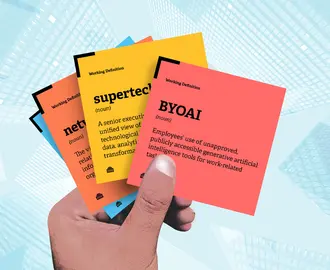Credit: Jennifer Tapias Derch
In today’s tech-propelled world, businesses rely on data and analytics to make informed decisions and drive growth.
Employee acceptance is critical in this race to embrace data-driven strategies, but change is never easy. Workers naturally worry: Will my job be disrupted or eliminated? Will my workload increase?
Change management is the secret sauce for driving ROI in these moments. Companies that do it successfully are three times more likely to meet objectives than companies that don’t, according to Beth Montag-Schmaltz and Erin Daly, change management experts affiliated with global digital services firm West Monroe.
In a presentation at the recent Chief Data Officer and Information Quality Symposium at MIT, the pair shared six ways to guide employees through the change brought on by the introduction of new technologies.
Recognize that employees are naturally resistant to change. This reluctance is called the “change curve.” This model, borrowed from the field of psychology, explains why adjustment isn’t immediate or linear but is predictable.
Related Articles
Our brains are hardwired to resist change, Daly explained. The amygdala, a region of the brain that processes emotions, responds before our prefrontal cortex, which is responsible for impulse control and problem-solving. Essentially, we feel before we think.
The change curve of employee adaptation begins with unawareness of a change, then segues into uninformed optimism before often spiraling downward.
“It starts with, you’re not really aware. You’re going about your business, and then you hear a little bit of information. Oftentimes, it’s aspirational: ‘Gen AI is going to make all of our jobs easier!’ It’s little bit of uninformed optimism,” Daly said.
Then reality sets in, and the amygdala gets to work. People wonder what changes might mean for their jobs and security.
“We call it ‘the valley of despair,’ ‘the pit,’” Daly said. When this change happens, the amygdala flips into protective fight-or-flight mode. Employees may feel stress or discomfort; the capacity for rational thought diminishes.
“As leaders, sometimes we may get frustrated [when employees resist change], but it’s really important to remember, this is just based on biology,” Daly said.
Ultimately, the arc can trend upward, toward skepticism, testing and exploration, and, finally, acceptance and proficiency.
To successfully introduce change into the organization, managers need to nudge employees away from this “amygdala hijack” and back to the comfort of the prefrontal cortex, where they are better able to absorb new information and move from skepticism to acceptance.
Remember that emotions are contagious. Because change is often destabilizing, effective managers model excitement, knowing that they stand a good chance of seeing that positivity mirrored in their employees.
Related Articles
“You’ve all been in rooms where you have a leader who’s super energized and passionate and excited, and you can’t help but feel that optimism. We’ve also all been in rooms where people come in very stressed, demanding, frustrated, and lacking patience. You immediately feel that, too,” Daly said.
The brain relies on external cues and connections from others to determine a person’s mood. Positive, solution-focused conversations make change more palatable. In fact, within two hours of being with others in a similar mindset, heartbeats sync and people share the mood of the room’s most emotionally expressive person: in this case, ideally, the change manager.
“The way you show up matters,” Daly emphasized.
Realize that leaders and people managers have different roles. Executive-level leaders set strategies and oversee outcomes. They frame the inspirational overarching business case for change.
Middle-tier change managers shine on a granular level. They’re in a position to make a personal, persuasive case for change. They can explain what change will really mean for employees in terms of workflow. They can manage skepticism and model optimism.
People managers and supervisors are critical in transformations. “They really need to ensure that they’re involved and know the kind of impacts that a transformation is going to have on a team, that they understand where people need to go for support,” Daly said. “These are critical roles in any transformation.”
Pause to allow line workers to catch up to the front-runners. When it comes to transformation, not everyone starts from the same place. Executives aware of change initiatives from their inception have had more time to adjust than employees swallowing new information at a companywide meeting. Respect the difference.
Daly and Montag-Schmaltz call this the “marathon effect,” alluding to the crowded start of a long-distance race. Leaders are already at the starting line, then off and running, before employees have even had the chance to line up.
“As a leader, you need to remember that you have way more information. … You have to remember where your teams are: You need to slow down [and] make sure you’re tending to that change curve for your teams and thinking about what they need to move through. Are they at the awareness stage? Do they need more information for understanding?” Daly said.
Name it to tame it. Just like any new product, company initiatives deserve branding and internal marketing to flourish: a motto, a T-shirt, a hashtag.
“Things that are memorable start to spread. Change really and truly is something that should be branded. It should have a name. It’s definitely got to engage both heart and mind,” Montag-Schmaltz said.
That’s why modern data officers can tell stories not only through numbers but also through anecdotal wins. They are data savvy, but they also have soft skills.
“There are folks who can make that bridge and help bring that heart piece to meet the brain,” Montag-Schmaltz said.
Storytelling — discussing small but important wins and encouraging employees to share their own — is key at the outset of a large project. It helps employees shift from being adopters to stakeholders.
“It’s a lot more powerful when your people start sharing those success stories and when they’ve had their fingerprints on them,” Montag-Schmaltz said. “How do we shine a light where folks are finding really great use cases to become more productive and amplify that across an organization? That takes some time. It takes concentration. It takes an investment in the people side. Those are the first pieces around creating a compelling story.”
Identify fast followers, and reward early efforts. Rewards and recognition programs matter. They affirm buy-in, create allegiance, and can create a domino effect of infectious enthusiasm.
Instead of trying to charm skeptics who might contaminate public opinion, capitalize on fast followers — team members who are typically highly engaged and are known as early adopters.
“Our philosophy is, don’t spend a lot of time [on skeptics] unless it’s someone who’s highly influential within your organization. … Know who your fast followers are to make sure that you can create this momentum and generate a movement,” Montag-Schmaltz said.
“When you think about human ROI, especially around readiness, a lot of it is perception-driven,” she said. “Perception is reality. You’ve got to manage that perception or that readiness component before launching something new or big.”
Read next: The key to cracking the data culture code



